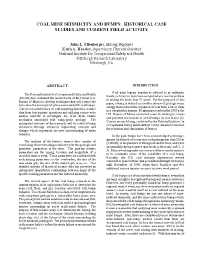Mining Publication: Coal Mine Seismicity and Bumps: Historical Case Studies and Current Field Activity
Original creation date: August 2000
The National Institute for Occupational Safety and Health (NIOSH) has continued the research role of the former U.S. Bureau of Mines to develop techniques that will reduce the hazards in the mining work place associated with coal bumps. Current research focuses on both analyzing historical seismic data from bump-prone geology. The anticipated outcome of this research will be reduced bump incidences through advanced engineering concepts and designs which implement the new understanding of strata behavior. The analysis of the historic seismic data consists of correlating observed mining seismicity with the geologic and geometric parameters at the sites. The primary seismic parameters are the timing, location and magnitude of a recorded seismic event. These parameters are correlated with such mining parameters as: the overburden, the size of the immediate gob, the size of the district gob area, etc. This detailed analysis of historical seismic data has provided an informative quantifiable relationship between many of the specific mining parameters and the induced seismicity.
Authors: JL Ellenberger, KA Heasley
Conference Paper - August 2000
NIOSHTIC2 Number: 20020921
Proceedings of the 19th International Conference on Ground Control in Mining, August 8-10, 2000, Morgantown, West Virginia. Peng SS, Mark C, eds., Morgantown, WV: West Virginia University, 2000 Aug; :112-120
See Also
- 60 Years of Rockbursting in the Coeur D'Alene District of Northern Idaho, USA: Lessons Learned and Remaining Issues
- Analysis of Multiple Seam Stability
- Determination of Sound Exposures (DOSES): Software Manual and Implementation Guide
- Development of a Statistical-Analytical Approach for Assessing Coal Bump Potential
- Diagnosing and Controlling Moisture-Sensitive Roof in Coal Mines
- Dynamic Failure in Deep Coal: Recent Trends and a Path Forward
- Investigation of a Rock-Burst Site, Sunshine Mine, Kellogg, Idaho
- Rock Bursting and Seismicity During Ramp Development, Lucky Friday Mine, Mullan, Idaho
- Task Analysis
- Technology News 536 - NIOSH Develops New Software to Analyze and Reduce Noise Exposure
- Page last reviewed: 10/25/2016
- Page last updated: 10/25/2016
- Content source: National Institute for Occupational Safety and Health, Mining Program


 ShareCompartir
ShareCompartir
